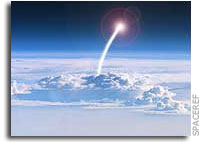Rising Above Tragedy – It Has Happened Before
 Past Transit Tragedies Point to a Way Forward for Virgin Galactic, Smithsonian
Past Transit Tragedies Point to a Way Forward for Virgin Galactic, Smithsonian
“Private spaceflight hit a large bump in the road to orbit last week, with Orbital Sciences’ rocket explosion followed days later by Virgin Galactic’s fatal spaceplane crash. But if early aviation and aerospace efforts can teach us anything, it’s that the key to surviving such tragedies is transparency and learning from any mistakes. And in a counterintuitive twist, the disasters may even increase public support for spaceflight and space tourism.”
 Keith’s note: Video of Challenger’s and Columbia’s loss is seared in our collective consciousness – both accidents caused prolonged self-examination and questioning as to whether it was all worth doing. Even commercial advertisements comparing consumer items to the shuttle were pulled. Yet NASA returned to flight – twice. When the shuttle fleet was retired there was exceptional interest and heated debate and overt food fights about who got the remaining shuttles – because of what they represented in people’s minds. Indeed huge portions of the population demanded that NASA keep them flying. Remember the flyovers and parades? Major cities stopped everything – just to watch. Yet these very same shuttles that flew over America to such acclaim are identical to the two shuttle vehicles we all saw torn apart with their crews on board. A symbol of tragedy – twice – is now a symbol of American pride.
Keith’s note: Video of Challenger’s and Columbia’s loss is seared in our collective consciousness – both accidents caused prolonged self-examination and questioning as to whether it was all worth doing. Even commercial advertisements comparing consumer items to the shuttle were pulled. Yet NASA returned to flight – twice. When the shuttle fleet was retired there was exceptional interest and heated debate and overt food fights about who got the remaining shuttles – because of what they represented in people’s minds. Indeed huge portions of the population demanded that NASA keep them flying. Remember the flyovers and parades? Major cities stopped everything – just to watch. Yet these very same shuttles that flew over America to such acclaim are identical to the two shuttle vehicles we all saw torn apart with their crews on board. A symbol of tragedy – twice – is now a symbol of American pride.









I think the Rosetta short film Ambition presents some of the ideas on why we do what we must do.
https://www.youtube.com/wat…
I don’t even know what I just watched.
I think some of the hysterics need to be calmed, particularly when it comes to the Antares rocket. The NK-33/AJ-26 is a heavily tested and verified engine which completed 4 missions before this incident. Which means at least 8 of these highly efficient engines performed flawlessly in actual missions(9 if we include the December 2013 Soyuz-2-1v launch). People need to remember first that it is exclusively an unmanned vehicle, and second that switching to a new engine means a completely new and untested configuration which can be just as risky. While the engines would make excellent museum displays or teaching tools, I’d still feel comfortable flying a payload with them especially if it makes the (insured) payload cheaper to launch.
I think you have totally missed the point of my post. Yup, you have. Your additional posts restating the exact same off topic points and personal insults have been deleted.
Since the intention was never to use them for human spaceflight, and so a somewhat higher risk could be acceptable, this is a reasonable point. However in the long run developing a US capability to produce reliable engines would be of greater benefit than the money saved by using the NK-33, particularly when the cost of even one failure is considered. If the engine were of recent US manufacture it might be possible to examine the manufacturing process, identify the point where the defect was introduced, and correct it. But since the engines were apparently inspected as thoroughly as possible during overhaul and no defects were identified, no corrective action is possible and the risk of another failure remains high. I would not use them.
My take on it is failure is a part of the process of moving forward.
It’s worth pointing out that between late 1908 and the end of 1920, almost 60 people were killed in aircraft accidents (not counting military losses), and many more were injured. In fact, the De Havilland DH-4 may have killed more people than any single national space program.
So–space flight, compared with atmospheric flight at an equally early stage of development, is safer.
This is not to diminish in any way the loss of life we have experienced, but some perspective is useful for those who would retreat from space because of risk. Yes, risk is there, but it is not as great as we imagine, and it is better managed than in early aviation. And–since aircraft are everywhere today–we obviously overcame greater levels of risk in the past. One could also point out that the rare crash of a commercial airliner robs us of more human life than the entire international space program to date.
I see a lack of understanding of aerospace here, and of flight testing, and some risk-aversion at work. However, I also see a strong vein of the old go-anywhere, do-anything spirit that characterized early aviation.
We can get through this and achieve great things despite the cries of distress from the sidelines. We simply need to persevere.
http://www.planecrashinfo.c…
http://www.wired.com/2010/0…
Or going to classic trek, Kirk — “Risk is our business!”